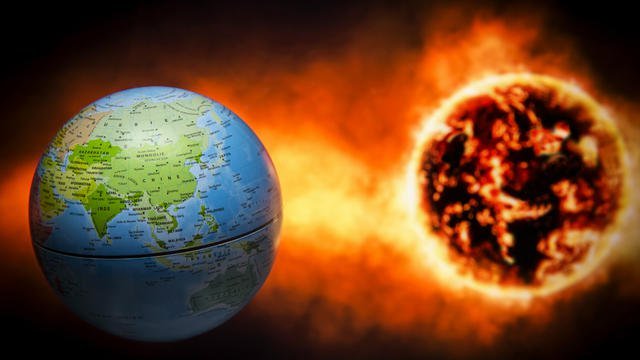13 concrete consequences of global warming - 13 conséquences concrètes du réchauffement climatique
13 concrete consequences of global warming


Health risks, increased poverty, threatened species and places ... Examples of the impact of global warming are numerous.
The COP21, in December 2015 in Paris, had set a goal of keeping global warming at less than 2 ° C. If we do not change our way of life to achieve this - and time is dangerously slow - the consequences will be dramatic.
Sunken paradise islands
In 50 years, the ocean level has risen by 10 centimeters. A trend that should continue or even accelerate in the years to come. According to NASA experts, an ocean rise of at least one meter is inevitable in the next 100 to 200 years. "Given what we know today about the expansion of the oceans with warming, and the melting of glaciers and ice caps, [...] it is almost certain that we will have an increase in the level of seas of at least one meter, and probably more, "said Steven Nerem last August.
The first victims of sea level rise are the Pacific archipelagos, especially the Marshall Islands, the islands of Polynesia, the Maldives (Indian Ocean) and parts of Asia (Philippi, Indonesia). According to a 2014 CNRS study, 10,000 to 20,000 islands could disappear completely during the century.
Faced with this announced disaster scenario, some countries are already trying to prepare themselves. Residents of Bikini Atoll, in the Pacific, have called for climate asylum in the United States.
Miami, Tokyo, Amsterdam flooded with water
Another consequence of rising sea levels is that many large cities built below sea level could be flooded with water. This is the case in Miami, New York, Tokyo, Singapore, Amsterdam and Rotterdam.
According to Steven Nerem, "it seems that it is already too late" for some American cities in Florida , including Miami. And if nothing is done to reduce the consumption of fossil fuels, New York could become uninhabitable in 2085.
Hurricanes and more intense cyclones
According to specialists, hurricanes and cyclones of greater intensity would be one of the direct consequences of global warming. Hurricanes such as Harvey, Irma , Maria , Jose, Katia, having touched the Caribbean region, draw their energy from the oceans. Thus, the scientists keep the population because their intensity could be increased tenfold with the increase of the terrestrial heat.
According to Valérie Masson-Delmotte, a climatologist with the Intergovernmental Panel on Climate Change (IPCC), the difference between the surface temperature of the Atlantic and the temperature at altitude was high. "The surface temperature of the tropical Atlantic has been particularly high in recent weeks, often at 1 to 2 ° C above normal," she says, adding that "climate change does not directly cause meteorological phenomena like hurricanes. But it increases their intensity, their frequency or their duration.
Heat records
The main objective of the Paris Conference is to keep global warming below 2 ° C. If this goal is not achieved, forecasters predict future temperature records and the multiplication of heat episodes. "Heat waves are likely to occur more frequently and last longer. With the warming of the Earth, we expect to see the currently wet areas receive more rainfall and dry areas to receive less rainfall, " said climatologist Thomas Stocker in 2013 in a report by the Intergovernmental Panel on Climate Change (IPCC). ).
Scientists predict a rise in the average temperature of the Earth's surface between 0.3 and 4.8 ° C depending on the amount of greenhouse gas emissions by 2100.
To illustrate this data, the WMO (World Meteorological Organization) invited weather presenters from different countries to present the weather of August 18, 2050. Evelyne Dhéliat's French report is eloquent: France will present very high temperatures since will do in 40 ° C in Paris and up to 43 ° C in Nîmes.
Episodes of polar cold in Europe
If global warming provokes heat records, it will also lead to cold episodes in France and Europe. Meteorologists point out that the famous gulf stream, which usually separates the cold air masses of the Arctic and North Pole from the warmer air of the northern hemisphere, is disrupted by climate change and is becoming less and less waterproof.
In February 2018, the temperature at the North Pole, on which entered a hot air mass, is thus higher than in Europe. Hot air arrived on the Arctic has indeed pushed the cold air to the South.
More frequent forest fires
Portugal, Canada, United States, Italy and France .... Forest fires have multiplied in recent months. One of the reasons: the heat waves are more and more frequent, which leads to dry and extremely hot weather conditions, favoring the occurrence of forest fires.
For climate scientist Hervé Le Treut, interviewed by FranceInfo, "global warming is one of the factors that can explain the multiplication of fires, but it is not the only one: there is also the human action, the drought sometimes related to warming, regrowth of forests. "
250 million climate refugees in 2050
Droughts, typhoons, floods, cyclones ... Climate change is causing an increase in the frequency and intensity of extreme weather events. Natural disasters that should continue to multiply in the decades to come, causing the migration of populations. In a report published in 2012, the UN predicted 250 million displaced people worldwide in 2050.
"There are already more climate refugees today than there are war refugees. Some 80% of them live in the countries of the South, but will they stay there? If we do not reach an agreement in Paris in December, they will be even more numerous in ten, twenty or thirty years, "warned Francois Hollande in an interview with the Parisian in September.
According to data from the Internally Displacement Monitoring Center (IDMC), 83.5 million climatic refugees were recorded between 2011 and 2014.
Explosion of poverty by 2030
The World Bank estimates in a report released in November 2015 that more than 100 million people could end up in extreme poverty if greenhouse gas reduction targets are not met. "The poorest are the hardest hit by climate change. The challenge we now face is to prevent climate change from plunging tens of millions of people into extreme poverty, "said Jim Yong Kim, President of the World Bank Group.
According to the institution, the poorest populations are thus threatened by "poor harvests due to reduced rainfall," the surge in food prices caused by extreme weather ... The African continent would be the hardest hit, soaring food prices up to 12% in 2030 and up to 70% by 2080.
The UN estimates that nearly 600 million people could suffer from malnutrition by 2080 . "Increasing the frequency and intensity of extreme weather events, rising temperatures and sea levels, as well as floods and droughts have a significant impact on the right to food," says the rapporteur. UN Special Report on the Right to Food, Hilal Elve.
Recrudescence of diseases
The World Bank also points out that global warming could have a health impact by increasing "the incidence of diseases due to heat waves and floods".
These phenomena could, in fact, lengthen the season of transmission of diseases spread by mosquitoes. A global warming of 2 to 3 ° C would increase by 5% the number of inhabitants exposed to malaria, an increase of 150 million people. And according to the WHO , "two billion more people could be at risk of dengue transmission by the 2080s".
Diarrheal diseases, most often caused by water contamination, could rise by 10% in the next 15 years.
Animals: one in six species could disappear
By analyzing the results of a hundred studies on the impact of global warming on wildlife, American researchers have established that one in six animal species could disappear if the current rate of greenhouse gas emissions greenhouse continues.
According to this study published in May 2015 in the journal Sciences, the number of species threatened with extinction increases with each degree Celsius "won". Thus, in the case where global surface temperatures increase by two degrees compared to the pre-industrial period, 5.2% of the species would be affected. A figure that reaches 16% with a rise of 4.3 degrees.
Mark Urban, principal author of the study and a researcher in the Department of Ecology and Biology at the University of Connecticut, threats of extinction also vary by region of the world: 23% of species are threatened in North America. South versus 14% in Australia and New Zealand. Some scientists even say that the 6th mass animal extinction has begun, a situation that the blue planet has not known for 66 million years.
Disappearance of the Great Barrier Reef
The largest coral reef in the world , spanning 348,000 km2 north-east of the Australian coast, is threatened by two phenomena: rising water temperatures and ocean acidification .
An IPCC report published in April 2007 warned of the risk of widespread coral bleaching in the event of an increase in ocean temperature of around 2 ° C. In addition, according to a report published in October 2014 on the occasion of the Convention on Biological Diversity (CBD), the pH of the oceans has increased by 26% in 200 years.
These two processes jeopardize the diversity of the Great Barrier Reef, which is home to 400 species of corals, 1,500 species of fish and 4,000 species of molluscs. By 2012, the site had already lost more than half of its coral grasslands in just 27 years . And the reef could continue to deteriorate to the same extent by 2022 if nothing was done to protect it, according to scientists at the Australian Institute of Marine Science (AIMS) and the Australian Institute of Marine Science. University of Wollongong (State of New South Wales).
The end of Bordeaux and Rhône Valley wines
While climate conditions are now ideal for grapes in these regions, global warming and decreases in rainfall could redistribute the geographic distribution of wine-producing regions around the world , a 2013 US study revealed.
"The area of land suitable for growing grapes will be reduced in many traditionally wine-producing regions, such as the Bordeaux region or the Rhone Valley, as well as in Tuscany in Italy. But there will be more and more favorable places in more northerly regions, in North America and in Europe, "said Lee Hannah, the lead author of this study.
Specifically, the area of land suitable for growing wine goes Europe will be reduced by 68% in 2050. The most pessimistic scenario is a reduction of 86%.
More frequent airplane turbulence
According to a 2013 study in Nature Climate Change, areas of turbulence are expected to increase significantly in the future. Based on a simulation of climate models, researchers estimate that turbulence could double by 2050. Their strength would also increase by 10 to 40%
"Aviation is partly responsible for climate change. Ironically, the climate is in the process of taking revenge by creating a more turbulent atmosphere, "commented one of the authors of the study, Professor Paul Williams.
This article appeared first on http://www.cnewsmatin.fr/monde/2018-04-08/13-consequences-concretes-du-rechauffement-climatique-715454
Reproduction rights CC BY 4.0 License (Attribution - Sharing under the same conditions)
I follow all the people who follows me! (If I have time, enough bandwidth and steem power...)

My 10 favorite posts:
 Vegan spring salad with spelled cubes, radishes and peas
Vegan spring salad with spelled cubes, radishes and peas

 A very cute cosplay - Sword Art Online - Silica
A very cute cosplay - Sword Art Online - Silica
 Small shoots - vegetable yogurt with coconut milk or almond milk - Les petites pousses – yaourt végétal au lait de coco ou lait d’amande
Small shoots - vegetable yogurt with coconut milk or almond milk - Les petites pousses – yaourt végétal au lait de coco ou lait d’amande

 Eat Like a Centenarian
Eat Like a Centenarian







All the pictures posted here are free pictures found on free websites, public instagram accounts or from websites allowing the sharing of their posts
Reproduction rights CC BY 4.0 License (Attribution - Sharing under the same conditions)
@steemitcards + "!commentcard"
My soul is spiraling in frozen fractals all around.